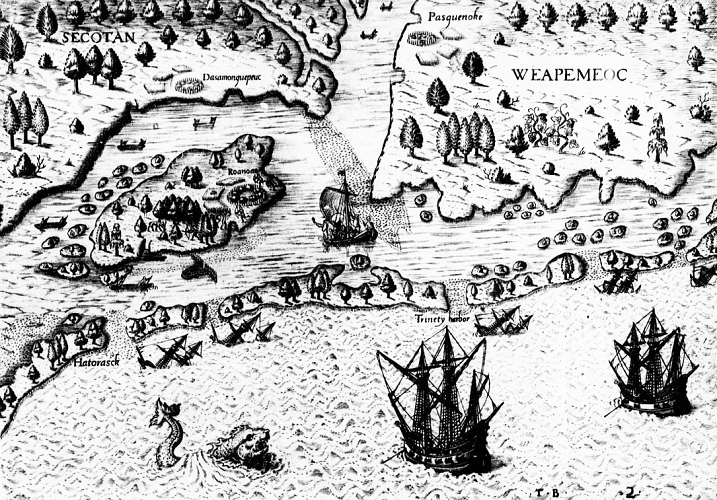Amadas, Philip
ca. 1565–?
 Philip Amadas, naval commander and explorer, was the son of John and Jane Amadas of Plymouth, England. In his youth he released his estate in the manors of Trethake, Penkelewe, to Sir Walter Raleigh and became a member of his household. It is from this association that he was sent in 1584, at age nineteen, to explore the coast of America for a suitable site for Raleigh's proposed colony. Amadas, like Arthur Barlowe, was captain of his own flagship, the Bark Ralegh, with Simon Fernandez as master and pilot. On 13 July 1584 they arrived at an inlet leading to an island named Roanoke by the natives. This inlet they named Port Ferdinando after the pilot, who was the first to discover it. For six weeks, Amadas and Barlowe explored and traded, visiting chief Wingina on Roanoke Island, before returning to England with the Indians Manteo and Wanchese on board.
Philip Amadas, naval commander and explorer, was the son of John and Jane Amadas of Plymouth, England. In his youth he released his estate in the manors of Trethake, Penkelewe, to Sir Walter Raleigh and became a member of his household. It is from this association that he was sent in 1584, at age nineteen, to explore the coast of America for a suitable site for Raleigh's proposed colony. Amadas, like Arthur Barlowe, was captain of his own flagship, the Bark Ralegh, with Simon Fernandez as master and pilot. On 13 July 1584 they arrived at an inlet leading to an island named Roanoke by the natives. This inlet they named Port Ferdinando after the pilot, who was the first to discover it. For six weeks, Amadas and Barlowe explored and traded, visiting chief Wingina on Roanoke Island, before returning to England with the Indians Manteo and Wanchese on board.
The next year, 1585, Amadas, now given the title Admiral of Virginia and second in naval command to Sir Richard Grenville, sailed again for the New World on the Tiger. He remained on Roanoke Island under the governance of Sir Ralph Lane for a year and possibly served as both admiral and colonel. He may also have been leader of the Chesapeake Bay expedition and was perhaps instrumental in making entrenchments for the Roanoke Island fort. In June 1586, Amadas and his fellow colonists left for England in Sir Francis Drake's ships. From that time on, nothing further is known of Philip Amadas.
References:
David B. Quinn, ed., The Roanoke Voyages, 1584–1590, vols. 1–2 (1955).
Additional Resources:
Roanoke Colonies Illuminated, East Carolina Universities: http://digital.lib.ecu.edu/hakluyt/upload.aspx?p=Philip%20Amadas&type=note&from=hakluyt
Amadas and Barlowe, National Historic Site, Fort Raleigh, National Park Service: https://www.nps.gov/fora/forteachers/amadas-and-barlowe.htm
Philip Amadas in LearnNC.
Barlowe, Arthur. The First Voyage Made To The Coasts Of America, With Two Barks, Wherein Were Captains M. Philip Amadas, And M. Arthur Barlowe, Who Discovered Part Of The Countrey Now Called Virginia Anno 1584. Written By One Of The Said Captaines, And Sent To Sir Walter Ralegh, Knight, At Whose Charge And Direction, The Said Voyage Was Set Forth. [Boston, Mass.]: [Directors of the Old South Work], [1898]. https://docsouth.unc.edu/nc/barlowe/barlowe.html
"Amadas and Barlowe explore the Outer Banks." Prehistory, contact, and the Lost Colony. LearnNC.org. http://www.learnnc.org/lp/editions/nchist-twoworlds/1846 (accessed June 25, 2012).
Barlowe, Arthur. "Captain Arthur Barlowe's Narrative of the First Voyage to the Coasts of America" in Burrage, Henry S. (editor). Early English and French Voyages, Chiefly from Hakluyt, 1534-1608. New York: Charles Scribner's Sons, 1906. Pages 225-241. online facsimile edition at http://www.americanjourneys.org/aj-034/ (accessed June 25, 2012).
Image Credits:
De Bry, Theodor. Wunderbarliche, doch warhafftige Erklärung: von der Gelegenheit vnd Sitten der Wilden in Virginia. Frankfurt: Johann Wechsel. 1590. https://archive.org/stream/cihm_94737#page/n3/mode/2up
1 January 1979 | Shirley, John W.